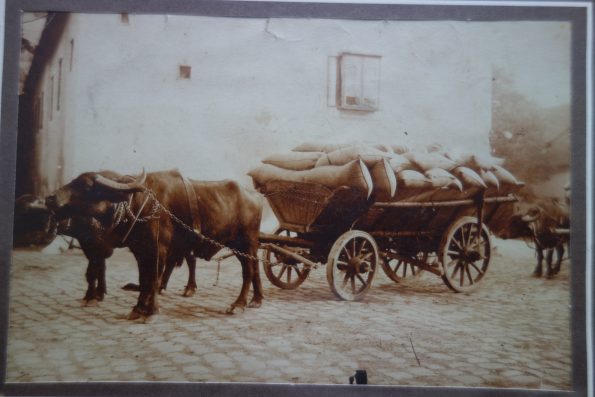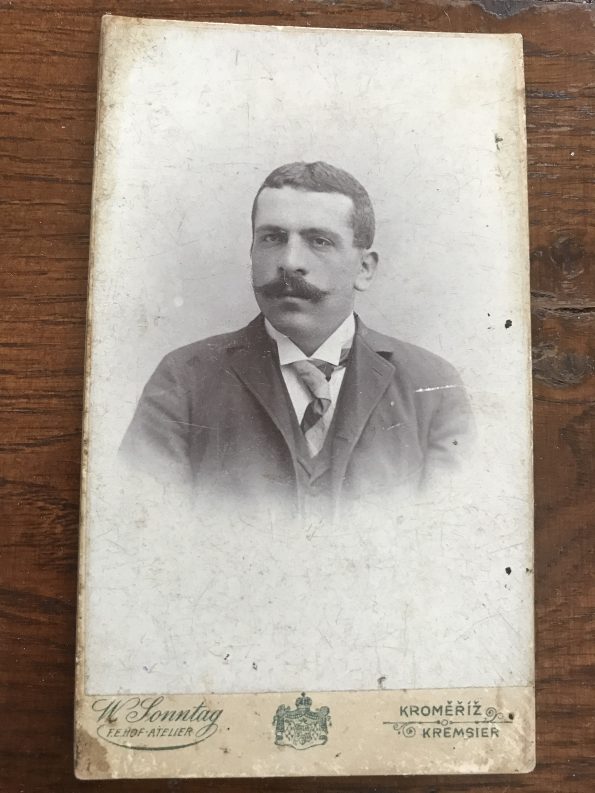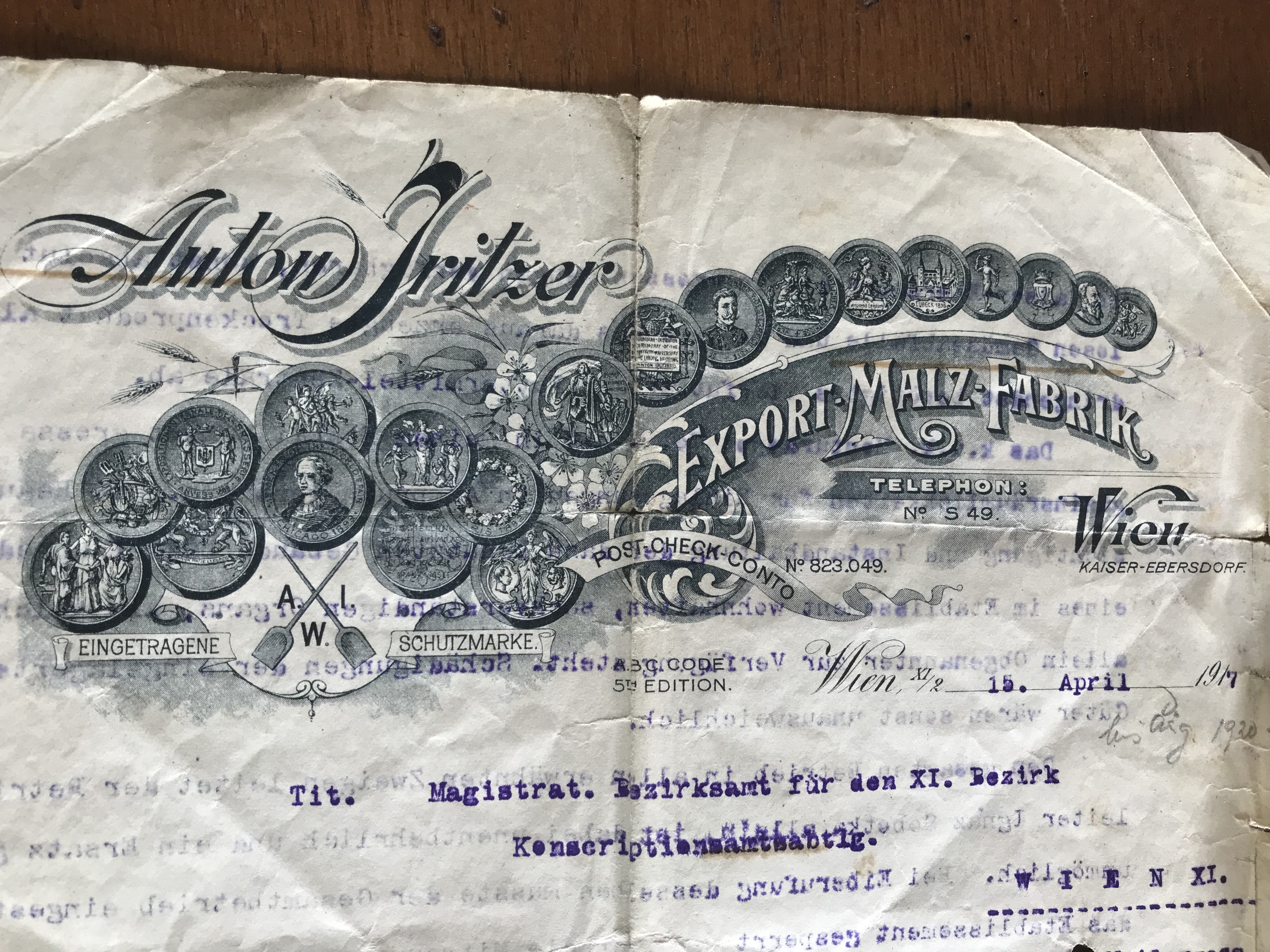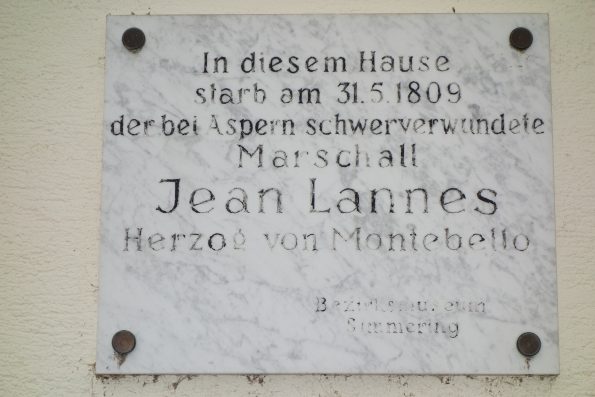
Oxen cart in front of the brewery in Kaiser Ebersdorf Vienna
My great-grandfather, Ignaz Sobotka, was born in Vienna, Ober Laa, in 1872 and his father Josef Sobotka, ran one of the cellars of the brewery “Hütteldorfer Brauerei” in Breitensee. Ignaz learned the trade of a beer brewer as an apprentice in Mährisch Budwitz (Moravské Budějovice, today Czech Republic) with the brewer Moritz Fried, who was probably a relative of his mother Sali Sobotka, née Fried. He completed his apprenticeship in 1890 and then gained experience as a travelling brewer staying at different breweries in the Austro-Hungarian Empire for approximately one year each. In the monarchy this working expertise of a travelling artisan was the condition for becoming a master of the trade and was called “Walz”. Original documents – appraisals of the brewers – prove that Ignaz worked as a brewer in the “Brunner Brauerei AG” (Lower Austria) from 1891-92 and from 1892-1893 already as “Kellermeister” (cellarer) and “Obermälzer” (head maltster) in the “Stadtbräuhaus Pressburg” (Bratislava, today Slovakia) of Herrmann Deutsch & sons. In 1898 he successfully attended a specialised course for maltsters in the 18th district of Vienna, Michaelerstrasse 25 at the “Österreichische Versuchs-Station und Akademie für Brauindustrie” (the academy of the brewing industry). From 1898 to 1899 he worked as a head maltster in the “Dampfbrauerei Znaim” (Znoimo, today Czech Republic) of Rudolf Wotzilka. From 1899-1902 he was a head maltster in the brewery in Eywanowitz (Ivanovice na Hane, today Czech Republic) “Brauerei & Malzerzeugung Wischauer & Posoritzer“, where he got to know his future wife, Rudolfine Weiss, and married her, the daughter of the doctor Josef Weiss and his wife Agnes, née Markus, in 1900. In 1902 he moved with his wife and the two daughters, Käthe, born in 1901 and Flora, my grandmother, born in 1902, to Kaiser Ebersdorf, near Vienna, where he was the head maltster and director of the “Export Malzfabrik Wien Kaiser Ebersorf” of Anton Iritzer (11th district of Vienna, Mailergasse 5) from 1902-1920. During the First World War his job was considered essential for the war economy as the malt production was switched to the production of foodstuff urgently needed during the war, so Ignaz was not conscripted.

Ignaz Sobotka as a young brewer, photo taken around 1900 in Moravia, Kromeriz/Kremsier
The booming sectors of the food industry in and around Vienna in the last decades of the Austro-Hungarian Monarchy were beer, spirits, sugar and malt coffee, whereby the brewing industry took the lead with famous industrialists such as Dreher, Mautner-Markhof, Meichl and Kuffner. Vienna was traditionally dominated by the wine industry, but then all around the 2-million metropolis breweries cropped up in the suburbs; in Nussdorf, Hütteldorf, Ottakring, Hernals, Liesing, Simmering, Schwechat, Kaiser Ebersdorf, Brunn and so on. The owners of many breweries were rich and influential indistrialists. The tax levied on beer was four crowns per hectolitre and the cities and provinces levied further taxes on beer. Additionally a mighty cartel of the beer brewers kept prices high and in 1882 the “Österreichische Brauerbund” (Association of Austrian Brewers) was founded to represent the interests of the Austrian brewers. This cartel tried to protect the beer brewers from the on-going fierce competition in the industry. In the area of today’s Austria 1,200 breweries existed in 1841 and this number was reduced to 289 in 1913. By the end of World War I half of those remaining ones had been wiped out as well.
The Austro-Hungarian Monarchy was one of the biggest wine producers worldwide, but the consumption of wine had continuously fallen due to devastating damages to the vineyards as a consequence of the vine pest, phylloxera, and a restructuring of the alcohol–producing industries. From the point of view of quality and costs the progress made in the industrial production of beer brewing made beer the better alternative to wine as an alcoholic drink for the masses. Furthermore beer became a fashionable drink of the intellectuals of the 19th century. In this way, Vienna, the “wine city”, was turned into Vienna, the “beer city”. Even in the traditional wine growing areas of Vienna, such as Nussdorf, Grinzing, Hernals and Ottakring breweries proliferated. The metropolis boasted new beer halls which offered various sorts of high-quality beer. The new types of breweries were one of the first modern food production industries with a high capital investment: steam engines and cooling facilities required high capital investment. New scientific methods resulted in better quality and longer durability of the product. The emergence of the railway as a means of transport increased the flexibility with respect to the location of the production, which further boosted the concentration of the industry. It is estimated that at the beginning of the 19th century the per capita consumption of beer in “Cisleithania” (the western part of Austro-Hungary) was only 20-30 litres, whereas at the end of this century it comprised approximately 90 litres. In today’s Austria the per capita consumption was 100 litres in 1910 – more or less the same as today. In comparison, the wine consumption fell from 120 litres per capita in Vienna around 1800 to 25.9 litres in 1913.
According to a study of Pfohl (“Wirtschaftskarte Österreich-Ungarn: Brau-Industrie“ 1918) most beer was brewed in Bohemia (10 million hectolitres), followed by Lower Austria and Vienna (4 million hectolitres) and Upper Austria and Hungary, each 3 million hectolitres, then the Alpine regions 2.5 million hectolitres, Moravia & Silesia 2 million hectolitres and finally Galicia & Bukovina 1 million hectolitres. The overall beer production of Austro-Hungary of approximately 25 million hectolitres was rather small compared to 70 million in Germany and 60 million in Great Britain in 1918. But the brewing industry was an important employer in Austro-Hungary: in Bohemia it employed around 12,500 workers in 1918, in Lower Austria and Vienna 5,100 and in Moravia 2,500 workers.
Anton Dreher senior established the biggest brewery on the continent. His father had come to Vienna from Lake Constance as a waiter and bought the brewery Klein-Schwechat in 1796. His son travelled to England to learn about the latest industrial methods in the brewing industry, put those into practice at home and further developed more sophisticated production processes. He combined the English malting process with the Bavarian brewing methods and developed a more durable product, the “Lagerbier” in 1836 – the famous “lager” was invented. In 1836/37 he produced 16,000 hectolitres per year and his son, Anton Dreher junior, reached an annual output of nearly 800,000 hectolitres around 1900. He expanded his brewery network across the whole Austro-Hungarian Monarchy from Bohemia to Hungary and Trieste. In 1900 the breweries of Dreher were the world’s biggest brewing enterprise with 1.25 million hectolitres. In 1905 the company was taken public and in 1913 it merged with Meichl’s brewery in Simmering and Mautner-Markhof’s in St. Marx. In 1926 the family dynasty ended with the death of his twelve-year-old grandson Oskar Anton. The beer brand “Dreher” is still widely known in Italy.
Another important Austro-Hungarian brewing dynasty was the family Mautner-Markhof. Adolf Ignaz Mautner rented the brewery of St. Mark in 1840 and successfully increased the output despite the nearby competition of Dreher. He improved the production and storing of beer with an efficient new cooling system and a new patented storing method, the “Normal-Bierlagerkeller System Mautner”. He further revolutionised the yeast production with the help of his son-in-law, Julius Reininghaus, and developed the so-called “Wiener Verfahren”, which allowed the production of high-quality yeast the year round independent from the brewing process. The Mautner-Markhof enterprise flourished and expanded into other sectors of the food industry, such as spirits.
The family Kuffner was an important dynasty of industrialists in the brewing industry, too. The Kuffners had started with spirits production in Lundenburg (Breclav, in today’s Czech Republic) together with a variety of trade enterprises and then acquired the brewery in Ottakring in Vienna. Moritz Kuffner studied chemistry and took over the enterprise of his father in 1882, which he took public in 1905. He built an astronomical observatory, the “Kuffner Sternwarte”, which still exists and was a renowned alpinist, philosopher and art collector.
Ignaz Sobotka’s, my great-grandfather’s, career as a beer brewer was somehow predestined as his father was running a cellar for the brewery ”Hütteldorfer Brauerei”. This was a traditional brewery located in the valley of the river “Wien” and had contributed to the commercial success of the area in the first half of the 19th century as a location for family outings and popular musical and dance festivities at the outskirts of Vienna. Before the innovations of Dreher the quality of Viennese beer must have been extremely low, but that did not prevent the ordinary people from flocking to the villages outside Vienna on weekends and festive days and enjoy beer, music and dance. Anton Bergmiller renovated and expanded the brewery and the affiliated inn with garden “Hütteldorfer Bräuhaus”. Since 1858 the company expanded due to the opening of the railway line to the west of Vienna, the “Kaiserin Elisabeth Westbahn” and the station in Hütteldorf together with another new line along Hadikgasse later on. According to many contemporary reports the inn “Hütteldorfer Bräuhaus” was the biggest attraction in the village. The concert hall of the inn was the location of the first concerts of the young Josef Lanner and Johann Strauss father who also returned to Hütteldorf as famous composers and performers. The attractions of the last decades of the 19th century were the so-called “Frühschoppen” (Sunday morning entertainment with music) when masses of people travelled to Hütteldorf, where famous artists performed, such as Hansi Niese and Alexander Girardi. Crown Prince Rudolf was seen there several times on his way to his hunting castle Mayerling. In 1912 the Viennese football club “Rapid” moved to the nearby “Pfarrwiese” stadium, which further boosted the business of the brewery because one entrance to the football stadium was next to the ticket office of the stadium. In 1890 the “Hütteldorfer Brauerei” was the fourth biggest in Vienna after “Schwechat”, “St. Marx” and “Liesing”. The lack of awareness of environmental protection led to the fact that all sewage was drained into the nearby “Mariabrunner Mühlbach” which then transported the polluted water into the river “Wien”. In 1882 experts complained about the extremely bad quality of the water which was contaminated by the sewage not only of the brewery, but also chemical factories along the river.
The garden of the inn was continuously enlarged before the First World War and the newly built railway line around the suburbs of Vienna, the “Stadtbahn”, designed by the famous architect Otto Wagner, brought more guests to the restaurant garden, especially on beautiful Sundays. The large beer cellars, one of which was run by Josef Sobotka, were located along the “Linzer Straße” in Breitensee. At “Linzer Straße” 480 the entrance to the enormous tunnel complex of cellars was located. Between 1862 and 1875 another large two-storey-deep cellar was dug opposite the existing one (“Linzer Straße” 455). While the cellars still exist, but cannot be accessed, the brewery and restaurant were gradually demolished before and after World War II.
Ignaz gained expertise as a brewer as a travelling fellow of the guild. It was still common at the time to learn the trade by travelling from one enterprise to the next, ”to take to the road” or the “Walz”, long after the Guild Regulations had been abolished in the Austro-Hungarian Empire. According to this custom a fellow of the guild had to take to the road for two to three years after the completion of his apprenticeship in order to get to know other enterprises and expand his knowledge of the trade. Young beer brewers of wealthy families even went as far as England, for example Anton Dreher. Yet the majority of the young brewers took to the road in the Austro-Hungarian Empire or Bavaria. Ignaz was apprenticed in Mährisch Budwitz (Moravské Budějovice) at the brewery of Moritz Fried, probably a relative of his mother’s. His apprenticeship certificate was issued on 3rd September 1890 in Mährisch Budwitz by the cooperative of the free brewers of Mährisch Budwitz after two years of apprenticeship and signed by Moritz Fried, the master of the brewery, “… he comported himself faithfully and morally during his apprenticeship, has learned diligently and has acquired the necessary skills, so that he is now free and can be recommended to the honourable brewers with respect to his usefulness.” This ceremonial discharge signifies the successfully completed apprenticeship and the start of the career as a fellow of the guild. The young brewer would then work for different breweries, usually for a year, and receive a certificate of conduct.
Ignaz then took to the road in Moravia, Pressburg (Bratislava) and in the vicinity of Vienna, namely in Brunn am Gebirge. From 1891-1892 he worked for the “Brunner Brauerei AG”, where he received the following certificate, “…. Herr Ignaz Sobotka worked in the brewery of this company from 4th September 1891 to 23rd June 1892 as brewer and comported himself faithfully and diligently to the utmost satisfaction during this time…” The “Brunner Brauerei” was originally a small brewery in a predominantly wine growing area that served mostly the villages Brunn and Maria Enzersdorf until the railway line from Vienna to the South “K&K Südbahngesellschaft” was opened in 1841 in this area. Funds were raised for the foundation of the “Brunner Brauerei AG” and the brewery had a direct link to the main railway line. The brewery’s main markets were Vienna and the places along the various railway lines, such as Raab (Györ), Ödenburg (Sopron), Tyrnau. But the competition was fierce. The company tried to increase the revenue by brewing speciality beer, the “Matador Kraft-Malz-Bräu” and organised every year a festival similar to the Munich “Oktoberfest”, the “Bierrummel” in the areas where thye usually stored the malt. Oxen and horse-drawn carts brought the beer to Vienna and in winter the ice from nearby lakes to the rock cellar, the “Felsenkeller” to be stored for cooling in the warmer seasons. Working the ice for the brewery was a welcome source of income in winter for the wine growers of the region. The morning call for the workers in breweries reminds of this important daily routine as reported by Ignaz: “Aufstehen, Keller waschen, Eis butteln!” (Get up, clean the cellar and put the ice in buckets!). In the 1930s the brewery and the malt production were closed. The lakes were filled up and the rock cellar was closed and filled up in 2010.

Brewery building in Eywanowitz (Ivanovice na Hane) in 2017

Rudolphine Weiss, Ignaz’ future wife
After working in Znaim (Znoimo) and Eywanowitz (Ivanovice na Hane), where Ignaz met and married Rudolphine Weiss, he moved with his young family to Kaiser Ebersdorf near Vienna in 1902 where he became head maltster and director of the “Export Malzfabrik Wien Kaiser Ebersorf” of Anton Iritzer (11th district of Vienna, Mailergasse 5) from 1902-1920. This brewery boasts a curious history. When Napoleon occupied Vienna for the second time in 1809 he commanded the crossing of the Danube near Kaiser Ebersdorf. On the 21 and 22 May 1809 Napoleon was defeated in the battle of Aspern and his Marshall Jean Lannes, Duke of Montebello, was wounded on both legs and transported to the house of the local brewer. He was visited by Napoleon several times and died there on 31 May. A commemorative plaque was installed at the house Mailergasse 12. This house was probably the brewery owner’s mansion at the time. In this road a brewery is documented since the second half of the 15th century. After the second Osman siege of the city of Vienna in 1683 Graf Thurn von Valsassina bought the destroyed brewery and the brewer’s mansion, called “Mühlbergerhof”. He did not only restart the brewery, but also rented the mansion to royal hunting guests because the emperor’s hunting castle Kaiser Ebersdorf was too small to accommodate all the noble guests.
After the duke’s death his head brewer bought the heavily indebted firm and turned it round. Johann Georg Uhl brewed excellent beer based on a secret family recipe that was well known in the whole area. In 1763 he had a chapel built in the name of his patron St. George and his coat of arms, the initials JGU and two crossed malt shovels can still be seen there, although the chapel had to be moved to its present location due to the construction of the tram line to Vienna. This part was the city tram line part of the railway line Vienna – Pressburg (Bratislava), the “Pressburger Bahn”, which was closed in 1945. This railway track was constructed from Vienna south of the Danube via Schwechat, Hainburg and Wolfstahl to Engerau (Petrzalka) to the centre of Pressburg (Bratislava) with a stop at Kaiser Ebersdorf and was opened in February 1914. An interesting detail are the original carriages that were designed by Otto Wagner for the “Pressburger Bahn” – the lower part of the carriage in brown wood and the upper part in white varnish. These stylish passenger carriages were used until 1960 on the northern line, the “Nordbahn”. This improved infrastructure link contributed to the attractive location of the brewery which was already well-known for its good –quality beer and beautiful buildings since the times of Uhl. After Uhl’s death the brewery continued its business until 1849. Then only the malting business was rented to Dreher until Anton Iritzer bought the property and enlarged it to a huge malt factory which was even represented at the Chicago World Fair in 1893. Anton Iritzer was the son of Charlotte Kuffner, the sister of the owner of the “Ottakringer” brewery, Jakob Kuffner.

Coat of arms of the Kaiser Ebersdorfer malt factory of Anton Iritzer (head of his letter asking for dispensation from military service of Ignaz Sobotka)


An interesting document of 15 April 1917 signed by Anton Iritzer asks for “… the dispensation from military service (in the First World War) of Ignaz Sobotka, manager of the malt factory and living on the premises of the factory (11th district of Vienna, Mailergasse 5) as he is indispensable for the war industry…. My company is busy producing fodder for animals and transforming worthless rubbish into animal fodder and I therefore need my manager. Further I have to dry coffee surrogate and I use 15,000 square metres of my garden to plant vegetables, cabbage and beans, etc. I furthermore collect the otherwise worthless vegetable cuttings in Kaiser Ebersdorf in large quantities and turn them into urgently needed animal fodder which I deliver to the fodder centre…. The k & k Uniform Depot has stored large quantities at my premises and these need an overseer who lives on site… All these tasks are carried out by my manager alone and he is therefore indispensable and there is no replacement. In case of his conscription operations would have to be terminated and the uniform depot would have to be vacated.” This led to the fortunate situation that Ignaz was not drafted for military service at the front line in World War I.

Living quarters of the brewery in Kaiserebersdorf





Ignaz and his family continued to live in the living quarters of the brewery the life of a well-to-do middle class family – the four daughters even had to address their parents with the formal third person “Sie”. The daughters had a nanny and led a carefree life. Yet Ignaz seemed to have been unhappy with the lack of a male offspring. So one day returning from one of his trips to the city in the horse-drawn cart of the brewery he brought home a homeless boy, of which there were many in the poverty-stricken parts of the growing metropolis. His wife, Leopoldine (Ritschi), was extremely angry and strictly ordered him to return the boy to where he had found him at once and never ever to try something like that again. One day there was a fire in the living quarters of the brewery and everyone was evacuated, but my grandmother Lola had just received a new pair of red shoes and sneaked back into the burning house to rescue her precious shoes to the horror of the whole family. Although the girls had a strict and conservative education, it was always Lola who got away with breaking the rules without serious punishment because she could rely on working her charm on her father. Once she decided to have her hair cut short in the new fashionable way and returned home with a small funny hat balanced dangerously to one side on her head. This made her father laugh out loudly and her grimaces saved her from severe consequences for having her long beautiful hair cut without permission.
After his death his son, Siegfried Iritzer took over the Kaiser Eberdorfer brewery and in 1920 the company “Erste Wiener Export-Malzfabrik Hauser & Sobotka” (today STAMAG) bought the malt factory. Ignaz Sobotka seemed to have been part owner of this company until in 1926 the production site was demolished because the malt production had been moved to Stadlau. Even today Austrian breweries receive their malt to a large degree from Stadlau. Today only a gym, where the malt floor was, and the “Hubertushof”, where the stables and the cellars were, still exist. The modernised mansion of the brewer family and St. George’s Chapel are the only still visible remnants of the brewer family Uhl. Ignaz Sobotka lost all his investments in the malt factory and his job, probably due to the difficult economic situation in Austria in the First Republic after the end of the Austro-Hungarian Empire and the subsequent Financial Crisis of 1929. He therefore had to move with his family to a tiny flat in Vienna and work for the company Teerag Asdag as a manual road worker.
Literature:
Prof. Pfohl, Wirtschaftskarten Österreich Ungarn, 1918
Christian M. Springer u.a., Wiener Bier-Geschichte, 2017
Roman Sandgruber, Traumzeit für Millionäre, 2013
